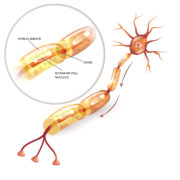
Myelin: The Gatekeeper to Developing Any Skill
I have a question for you. Have you ever heard the phrase muscle memory? I certainly have. In fact, I’ve used that very phrase many times over the last 25+ years of coaching health and fitness with my clients. I couldn’t tell you where I heard it in the first place.
I imagine a coach somewhere along the way probably said it. Now, here’s another question. If our muscles have memory, where does that memory come from? Now we’re heading in a direction that is quite fascinating to me! Most recently I finished an excellent book and in it author Daniel Coyle discusses some of the most recent research directed toward answering that question. The book discusses skill development in all of its neurophysiological and practical glory. Whether that skill is playing an instrument, learning a new exercise, or improving our talent in the kitchen there is one universal component to mastery. The answer is myelin.
So What is Myelin?
So what is myelin you ask? Simply, it is the insulating layer that covers nerve fibers. Much like rubber lining around a copper wire makes the electrical signal stronger and faster by preventing electrical energy from “leaking out”, so too does myelin around nerve fibers. Until more recently myelin was more or less overlooked as having any real purpose except to protect our nerves and improve nerve conductivity. Neurologists were aware of certain autoimmune diseases that attacked myelin but most research well into the 1980’s was primarily focused on changes to neurons and synapses rather than towards myelin itself.
It was not until around 2000 that myelin started to get more attention. A new and powerful technology called diffusion tensor imaging (DTI) allowed neurologists to measure and map myelin inside living subjects. What they found was incredible as they saw links between myelin deficiencies and a variety of disorders, including dyslexia, autism, attention deficit disorder and even post-traumatic stress disorder.
What Does the Science Say?
As many researchers focused their attention with the new technology on myelin’s link to disease and disorders, another group began to form that placed their focus on normal and high-functioning individuals. The findings started to get exciting as these pioneering researchers discovered that there was a direct proportional relationship between hours of practice and the amount of myelin present.
Still other researchers such as Dr. Douglas Fields, director of the Laboratory of Developmental Neurobiology at the National Institutes of Health in Bethesda, Maryland, uncovered the mechanism by which these myelin increases happened. I’ll give you the simpler version. Certain supporter cells are stimulated to wrap more myelin around a nerve fiber when it fires. The more the nerve fires, the more myelin wraps around it. The more myelin wraps around it, the faster the signal travels.2 Imagine myelin as the transformer of narrow alleys into broad, lightning-fast superhighways.
Practical Application
Let’s get practical now. The key to developing your own healthy layering of myelin is practice. I’m not just talking about any kind of practice though. No, instead I’m referring to very deliberate practice, complete with lots of mistakes.
Imagine a skill that you now have and that you feel really good about yourself for having. Now think back to when you didn’t have that skill. How did you go from no skill to amazing talent? You practiced. And when you practiced you probably blocked out other distractions, you positioned time and did so regularly enough to create improvement, and you were passionate about what you were practicing.
This last part is a real key. Many of us with the best of intentions seek to change something but we stumble and give up as soon as we’re not able to improve to our liking in some made-up time frame of our own creation.
Fail Away!
A prime tenet of skill acquisition and therefore myelinating of our nerve fibers is to make mistakes, regroup, and try again. We cannot be afraid to fail because it is the constant firing of the nerves involved with whatever we are trying to learn that stimulate the supporter cells to lay down more myelin. So the next time you find yourself really frustrated with learning something, an exercise, a new song, a habit, ask yourself if you’re really invested in change. If you find that you’re not, re-evaluate your “why” and come at your goal differently. And if you’re answer is yes, simply embrace your mistakes, learn from them and keep on keeping on. You will achieve success simply by sticking to this formula.
1 – Coyle, Daniel. The Talent Code: Greatness Isn’t Born: It’s Grown, Here’s How. New York: Bantam, 2009. Print.
2 – Ishibashi T, Dakin KA, Stevens B, Lee PR, Kozlov SV, Stewart CL, Fields RD (2006)
Astrocytes promote myelination in response to electrical impulses Neuron Mar 16, 49(6), 823-32
Introducing Our New Weekly Show – A Fit Bit With a Bostonian & a Brit
In September I came up with the fun idea of pairing our resident Bostonian, Marge Furash, with our resident Brit, Marny Wellman, to do a once weekly show on some kind of fitness-related topic that we can all engage with. Click on the link to hear our most recent episode! We’re talking myths associated with age like sex, memory and staying able-bodied among other things. You’re guaranteed at least one out loud giggle.
Client Spotlight – Lissa Hastings
- How did you hear about BodyBasics?
Actually I was a drive by. BB looked like a smaller gym that may give more personal attention. We had moved from Santa Fe where I had been spoiled by a fantastic trainer. I hadn’t found that right person here so I popped in for a look-see. I could tell from the moment I was greeted by Kris Litten that I had stumbled into my new routine.
2. Did you evaluate other gyms or trainers before deciding on coming to us? If yes, what were other places missing that BodyBasics was able to provide?
Yes. I am not a big box kind of gal. The mega gyms give no appeal. I did find a smaller gym but was unimpressed by their knowledge and quality of training. I have a friend who trained me at home for a bit but our sessions quickly turned into gab/therapy fests….not efficient….
3. Ultimately, why did you choose BodyBasics over other options?
I chose BB for the small gym atmosphere where everybody knows your name, kinda like Cheers but without the beer. Positive feedback and their ongoing Trainer education are key. Also, learning about what functional fitness can do for me as I age will hopefully keep injury at bay.
4. What goals did you have when you started at BodyBasics?
My goal initially was to get back into a routine. BB is key for my strength and endurance goals.
5. How long have you been training at BodyBasics? What are some personal successes you have achieved so far?
It will be my 5 year anniversary January 20th, 2021!
Personal successes? Maintaining weight loss from 6 years ago…mostly. Advancing strength and endurance, better balance.
6. To someone reading who may be uncertain still about investing in themselves, and with us at BodyBasics, what would you say to them?
BB is a great small gym with knowledgeable trainers able to help you along at any level of ability. The guidance and ever changing work outs keep you engaged and camaraderie ensues.
“Shout Outs”
Shout outs are about us voicing victories we witness you all having at BodyBasics. This month’s are extra special because all of these shout outs were personally penned by your trainers. Enjoy!
- From the X-man – Shout out to Mark Blessington for his continued improvement on his squat form and range of motion. When Mark first started at Body Basics he had severe knee pain that prevented him from performing a squat unassisted, now his squats look fantastic and he’s even adding resistance. Awesome job Mark, keep up the good work!
- From Kristian – Shout out to Maureen Roll! She went hiking for 2+ miles up and down steep hills and when she was done with the walk she didn’t need any type of pain medication and was not short of breath! When Kristian asked her if previously she’d need medication after a walk like that, her answer was “Oh, I just absolutely wouldn’t have attempted the walk!
- From Amanda – Shout out to Fred Page for getting back out on the pickleball court after taking some time off.
- From Vadim – Shout out to Jayne Schneuer! Jayne came to BodyBasics to improve her balance and has seen drastic improvement in only a few weeks and she has also noticed that she is getting up easier from her recliner without the help of her arms. Way to go Jayne!
- From Chris – Shout out to Leah Geistfeld! Leah has been doing once weekly virtual sessions with me. She always comes with a BEAUTIFUL smile on her face, a playful spirit and a willingness, most of the time, to put her all into every exercise I give her. We have fun every session, even when doing deep squats.
Recipe – Rasta Pasta
We don’t eat pasta frequently but when we do, I have had fun with this recipe! It’s spicy, it’s creamy, there’s veggies, there’s chicken, and cheese… there’s basically no flavor or texture that this dish doesn’t have. It’s rare to find a pasta dish with a good level of spice, and the jerk seasoning in this recipe does just that. I have used different veggies, added spice with different peppers and even used shrimp instead of chicken.

Ingredients
1 lb. penne pasta
boneless skinless chicken breasts (about 1 1/2 lb.)
2 tbsp. jerk seasoning, divided
Kosher salt to taste
2 tbsp. extra-virgin olive oil, divided
1 each red, green and orange bell pepper, sliced
1/3 c. sliced green onions, plus more for garnish
3 cloves garlic, minced
1/2 c. low-sodium chicken broth
3/4 c. heavy cream
1/2 c. freshly grated Parmesan, plus more for garnish
Instructions
- Cook pasta according to package instructions to al dente. Drain and set aside. Season chicken breasts all over with 1 tablespoon jerk seasoning and salt. In a large skillet over medium heat, heat 1 tablespoon oil. Cook chicken until golden and no longer pink, 8 minutes per side. Remove from pan and set aside to rest.
- Add remaining oil and cook peppers until mostly tender, 3 to 4 minutes. Add green onions and garlic and cook until fragrant, 1 minute. Season with remaining jerk seasoning.
- Add chicken broth and heavy cream and let simmer until thickened, 5 minutes. Slice chicken. Add Parmesan and stir until melted, then add pasta and chicken and toss until completely combined.
- Garnish with green onions and more Parmesan and serve
Recipe credit from Delish.com
Team BodyBasics
Chris, Kris, Kristian, Amanda, Dustin, Xavier, Vadim, and new addition, Samantha
